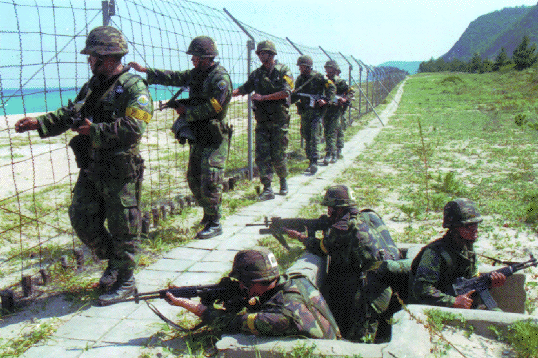
DMZ Korea (Author: Institute for National Strategic Studies)
In 2001, I travelled to the DMZ (Demilitarized Zone), an expanse of land that straddles the border separating North and South Korea. One thing I found most striking, as our tour bus pulled up in the parking lot on the South Korean side, was amidst the barb wire and fencing, there was an almost pristine environment of green vegetation and birds zipping around. With close to no human penetration into the DMZ since it was established in 1953, the zone had become like a nature reserve.
I remember at one point of the tour we were able to stare across the border to get our first glimpse of North Korea (also known as the Democratic People’s Republic of Korea or DPRK). Our eyes peered on a village called Kijong-dong, also called “Peace Village” by the DPRK, but referred to by others in the world as “Propaganda Village”.
According to photographer Kurt Wahlgren (dailypropaganda.com) who had taken pictures of the village’s buildings with blue-tiled roofs, “The official position of the North Korean government is that the village contains a 200-family collective farm, childcare center, clinic, and primary and secondary schools.” It gets its “Propaganda Village” nickname because it’s said that the enclave was built for the purpose of showing South Koreans (possibly to encourage defection) that the DPRK’s contrasting political regime has created an ideal place to live. It’s said that nobody actually lives there, except possibly soldiers who take temporary residence inside the empty buildings.
I remember the uncanny feeling I had looking over at the village. I couldn’t see a moving car nor people walking along the sidewalks—the streets gave the impression of a ghost town. This image reinforced the idea that North Korea is a mystery to much of the world. Very few North Koreans have access to the Internet. Travel inside and out of North Korea is limited compared to most countries and it seems in most cases those that visit the DPRK have to be on a government-approved organized tour.
In recent weeks, North Korea has been stepping up its threats, talking of nuclear warhead or missile attacks against South Korea, the U.S. military bases in Guam and Hawaii, Japan and even the continental U.S. There are numerous theories on whether the DPRK (now led by Kim Jong-un who succeeded his father Kim Jong-il in December 2011) can actually pull off these threats. Lending to the mystery of the country, there are also theories that Kim Jong-il’s motives are not actually warfare.
On March 29, U.S. House Homeland Security Committee Chairman Michael McCaul stated, “North Korea continues to openly threaten the United States. While it is unlikely that the regime has the capability to carry out its plots, we still cannot ignore its violent intentions.” According to Friday’s CNN report “North Korea: Who’s in the crosshairs?” by Kyle Almond, it’s thought that the DPRK’s missile capabilities would not be able to reach Guam, Hawaii or the continental U.S., but the weapons’ range may make South Korea and Japan viable targets.

Locator map of Guam and surrounding countries (Author: Central Intelligence Agency)
Still the U.S. Department of Defense issued a press release on Friday stating, “Missile defenders preparing for the deployment of the Terminal High Altitude Air Defense System to Guam are ready for the mission…”; and on March 31, CNN’s Gregory Wallace reported, “…the Obama administration increased its military capacity on the U.S. West Coast and conducted training exercises with South Korea, where nearly 30,000 U.S. troops are stationed.”
In a March 31 interview on the ABC news show “This Week,” the former chairman of the House Homeland Security Committee, member of the House of Representatives Peter King stated that North Korea’s statements are “no empty threat” but “that [Kim Jong-un] may feel to save face he has to launch some sort of attack on South Korea, or some base in the Pacific.”
The Guardian’s Jim McCurry elaborated in his article “Kim Jong-un has made a decent fist of rattling the US,” suggesting that the North Korean leader’s motives are to earn the trust and respect from his people and to incite the U.S. to provide his country with financial aide. (According to McCurry, two thirds of North Korea’s population “face food shortages”.)
As the stream of headlines pour out trying to anticipate North Korea’s next move, I think of the little village in the DMZ and the 24 million citizens who actually live within the country. I don’t know if I’ll ever get to visit North Korea, but I can’t help but think if I had the chance to sit down and chat with someone who lives there, despite major cultural and socioeconomic differences, we’d probably share some key things in common—a love for those we hold most dear, and perhaps even a love for nature, like that encased by the DMZ’s barb wire and fence.



